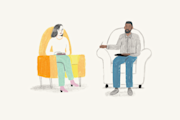Cognitive Behavioral Therapy or CBT therapy focuses on the interconnection between our thoughts, feelings, and behaviors.
If you have patterns of thinking that lead you to unhealthy behaviors, CBT may be helpful for you.
CBT focuses on changing our thought patterns and coping behaviors from problematic emotional responses to more adaptive responses.
What’s CBT and how does it work?
CBT stands for cognitive behavioral therapy.
Also called cognitive therapy, this type of counseling approach was first developed in the 1960s by psychiatrist Dr. Aaron Beck, and it’s is often short-term and skills-based.
There are three underlying parts of cognition in CBT:
Cognitive distortions aka “thinking distortions”
Automatic negative thoughts
Underlying beliefs
We’ll explore each in more detail below.

What are 4 types of distorted thinking?
Cognitive distortions are patterns of irrational thoughts prevalent among many individuals with mental health disorders.
These errors in logic can change the way we feel, react, and behave.
Common cognitive distortions include:
All or nothing thinking. Seeing a concept in two extremes, there is no middle ground. For example: “My day was terrible, or it was great.”
Minimization. Disqualifying positive characteristics, accomplishments, or successes.
Mind-reading. Assuming you know the thoughts or intentions of another person.
Fortune-telling. The tendency to try and predict the future.
Examples of automatic negative thoughts (ANTs)
Automatic thoughts are how we interpret events as they happen in the present moment.
These immediate thoughts can shape how we feel or behave in response.
If a friend doesn’t respond immediately to our text, an individual with automatic negative thoughts (ANTs) may think: “My friend doesn’t want to talk to me.”
That’s an example of an automatic negative thought.
And this reaction may cause us to feel upset with our friend or influence us to feel sad or lonely.
On the other hand, if our automatic thought is: “My friend must be busy with something else right now.” This thought may elicit different feelings in general as well as different interpretations about the friendship.
When we’re about to give a presentation or speech, examples of automatic negative thoughts that may pop up are: “I’m going to embarrass myself,” or “People are going to think I’m boring.”
In CBT, the premise of automatic negative thoughts is that people have dysfunctional automatic thoughts that may be mistaken.
Automatic negative thoughts can play a substantial and detrimental role in our mental health.
What are common core beliefs and where do they come from?
Underlying beliefs influence how we perceive and interpret the events in our world. Our life experiences shape our beliefs.
In cognitive behavioral therapy, there are two different levels of underlying beliefs. Core beliefs and intermediate beliefs form our rules for processing information.
Core beliefs are global beliefs we have about ourselves and the world. Alas, these often can be overgeneralized and rigid.
Examples of a negative core beliefs
“I am not worthy of love.”
“People cannot be trusted.”
“I am a failure.”
Core beliefs influence intermediate beliefs which consist of rules and assumptions.
Examples of negative intermediate beliefs
“If I’m skinny, then I’ll be loved by others.”
“I have to do my work perfectly, or I’m inadequate, and my supervisor won’t like me.”

The benefits of CBT
Cognitive behavioral therapy has numerous benefits for a wide variety of mental health disorders.
According to therapist Jen Thurman, LPC, “CBT is used for various diagnoses—it helps with impulsivity and helps clients rethink a situation before responding.”
In a 2018 Frontiers in Psychology article titled “Why Cognitive Behavioral Therapy Is the Current Gold Standard of Psychotherapy,” the authors argue that CBT is the gold standard, aka the best standard we have in the field at the moment, because it’s been heavily and carefully researched.
“Cognitive behavioral therapy was the first form of psychotherapy tested with the most stringent criteria of evidence-based framework used in the health field,” the authors write.
Research has demonstrated CBT’s effectiveness in treating:
Anxiety disorders
Panic disorders
Post-traumatic stress disorder (PTSD)
One systematic review and analysis looked at the effectiveness of CBT therapy on over 4,000 individuals with anxiety disorders, PTSD, and OCD.
The research found that a moderate reduction in anxiety symptoms was present for up to 12 months after completing CBT treatment in those with anxiety disorders and PTSD.
What does a cognitive behavioral therapist do?
Cognitive behavioral therapists utilize a variety of skills and techniques to help us become more aware of our thoughts, feelings, and behaviors—and to understand how these three components are interrelated.
The goal of a cognitive behavioral therapist is to help us become aware of and reflect on unhealthy patterns and work toward replacing them with healthier habits.
Cognitive behavioral therapists tend to focus on what is happening in the here and now.
The role of a therapist and client in cognitive behavioral therapy is a collaborative one.
A good cognitive behavioral therapist will assess why you came to therapy, gather background on the problem, and work to build trust and rapport with you.
What’s an example of cognitive behavioral therapy?
In a typical CBT session, your therapist will:
Do a mood check-in with you
Set the agenda by helping you identify problems you want to work on this week
Review previous therapy sessions and previous homework assignments to connect to this week's problems.
Collaboratively discuss, problem-solve, and build skills around your identified problems.
Ask you for feedback about what is and isn’t working in therapy.
CBT works in individual or group sessions. For depression and mood disorders and/or anxiety disorders, treatment can generally require 5-20 sessions.

Examples of CBT techniques
Because CBT focuses on the cognitive triad, which refers to the interconnection between thoughts, feelings, and behaviors, there are five steps for working on beliefs about events in our lives.
In CBT, this is referred to as the ABCDE model. This coaching framework was developed by Dr. Albert Ellis as part of Rational Emotive Behavioral Therapy (REBT), though this model is often used in CBT today.
The ABCDE method proposes that life events are not what actually cause our distress—but rather our beliefs about the events cause us distress.
The five steps help us work toward acceptance of rational beliefs and help us dispute any irrational beliefs we might have.
What are the 5 stages of the ABCDE method?
A- Activating event or situation
B- Beliefs about the event
C- Consequences of the event
D- Disputation of beliefs
E- Exchange old beliefs for new approach
Let’s try out an example to demonstrate the ABCDE model in action:
A- Your boss criticizes you at work. (Activating event)
B- You think, “I am a failure.” (Belief about the event)
C- You begin to feel anxious at work and therefore spend long hours in the office (Consequence)
D-You challenge whether “I am a failure.” is a rational thought
E- If you identify that the belief is irrational, and you exchange the old one for a more helpful one, such as: “Just because my boss wasn’t happy with my work at the moment doesn’t mean I’m a failure.”
In addition to the ABCDE model, CBT also uses other cognitive and behavioral techniques, including:
Socratic Questioning
Journaling
Validity testing
Guided imagery
Imagery-based exposure
Exposure therapy
Modeling
Flooding
How do I find cognitive behavioral therapy near me?
If you think CBT may be beneficial for you, check out the Monarch Directory by SimplePractice to find a therapist near you who specializes in cognitive behavioral therapy and/or many other effective therapeutic approaches.
Contact a therapist who specializes in CBT for a free consultation to discuss whether cognitive behavioral therapy may be right for your specific needs.
READ NEXT: How CBT and CBT-I Can Help With Sleep Issues and Insomnia
Need to find a therapist near you who specializes in CBT? Check out the Monarch Directory by SimplePractice to find licensed mental health therapists with availability and online booking.
Chand S, et al. (2021). Cognitive Behavior Therapy. https://www.ncbi.nlm.nih.gov/books/NBK470241/#:~:text=In%20the%201960s%2C%20Aaron%20Beck,(CBT)%20or%20cognitive%20therapy.
David D, et al. (2018). Why Cognitive-Behavioral Therapy is the current gold standard of psychotherapy. https://www.frontiersin.org/articles/10.3389/fpsyt.2018.00004/full
Field T, et al. (2015). The New ABCs: A Practitioner’s Guide to Neuroscience-Informed Cognitive-Behavior Therapy. http://www.n-cbt.com/uploads/7/8/1/8/7818585/fieldbeesonjones_2015.pdf
Kaczkurkin A, et al. (2015). Cognitive-behavioral therapy for anxiety disorders: an update on the empirical evidence. https://www.ncbi.nlm.nih.gov/pmc/articles/PMC4610618/
M. van Dis E, et al. (2019). Long-term outcomes of cognitive behavioral therapy for anxiety-related disroders. https://jamanetwork.com/journals/jamapsychiatry/article-abstract/2756136
Rice R. (2015). Cognitive-Behavioral Therapy. https://fisherpub.sjfc.edu/cgi/viewcontent.cgi?article=1072&context=nursing_facpub






